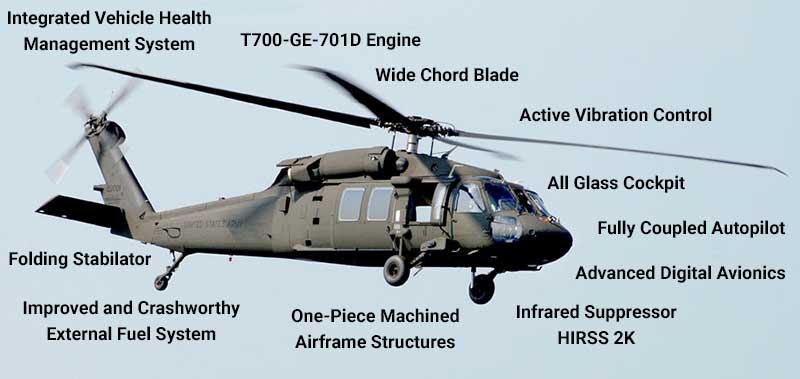Safety First: Vital Steps in UH 60 Helicopter Upkeep
Safety First: Vital Steps in UH 60 Helicopter Upkeep
Blog Article
Comprehending the Mechanics and Design Behind Uh 60 Helicopters
The UH-60 helicopter, commonly known as the Black Hawk, stands as a pinnacle of modern rotorcraft technology, symbolizing a blend of robust engineering and elaborate mechanics. As we peel back the layers of the UH-60's design, a world of intricate systems and meticulous engineering comes to light.
History of UH-60 Helicopters
The history of UH-60 helicopters traces back to the late 1970s when the United States Military sought a sophisticated and functional utility helicopter to replace its aging fleet. In action to this demand, the Sikorsky Aircraft Company developed the UH-60 Black Hawk helicopter. Presented in 1979, the UH-60 promptly ended up being a staple in armed forces operations as a result of its outstanding abilities.
The UH-60 was developed to excel in a variety of goals, including army transport, clinical emptying, electronic warfare, and special procedures. Its capability to adapt to various functions made it a valuable property to the U.S. uh 60. Military and other army forces worldwide
For many years, the UH-60 platform has actually undergone numerous upgrades and variations to boost its performance and maintain pace with advancing objective needs. These helicopters have seen considerable service in problems such as the Gulf War, Afghanistan, and Iraq, showcasing their integrity and flexibility in varied operational atmospheres. The UH-60's abundant history is a testimony to its long-lasting legacy as a top utility helicopter.

Engine and Power Systems
Utilizing cutting-edge propulsion technology, UH-60 helicopters are geared up with sophisticated engine and power systems to guarantee optimal performance and integrity in a variety of operational scenarios. The UH-60, commonly called the Black Hawk, is powered by 2 General Electric T700-GE-701D engines, each efficient in delivering up to 1,940 shaft horse power. These turboshaft engines supply the required thrust for the helicopter to execute its goals successfully, including army transport, clinical emptying, and combat assistance.

Blades System and The Rules Of Aerodynamics
Just how do the blades system and the rules of aerodynamics of UH-60 helicopters add to their functional effectiveness and trip abilities? The rotor system of the UH-60 helicopter plays a vital duty in supplying lift and propulsion. The UH-60 includes a four-bladed, completely verbalized rotor system that permits high maneuverability and security throughout trip. This style enables the helicopter to perform a large range of goals, from transportation and clinical emptying to combat procedures.
The rules of aerodynamics also play a key duty in the performance of UH-60 helicopters. The streamlined body and rotor blade layout lower drag, enabling the helicopter to achieve greater speeds and better gas effectiveness. The wind resistant style of the UH-60 also adds to its capability to run in varied environmental problems, over here including warm temperatures and high altitudes.
Avionics and Flight Control Systems

In its detailed coordination with the rotor system and the rules of aerodynamics of UH-60 helicopters, the avionics and trip control systems create an important network of modern technologies forming the aircraft's operational abilities. In the UH-60, these systems consist of electronic display screens, communication radios, GPS navigation, weather condition radar, and autopilot systems.
The trip control systems of the UH-60 are in charge of converting the pilot's inputs into the appropriate modifications to the rotor system, making sure steady trip and ability to move. These systems are composed of hydraulic actuators, servos, and computer systems that interact to regulate the main and tail rotors, as well as other flight control surfaces. By precisely managing the helicopter's flight dynamics, these systems enable pilots to perform a variety of missions, from transport and search-and-rescue to combat procedures, with accuracy and his response self-confidence.
Function and Applications in Air Travel
Avionics systems in UH-60 helicopters encompass a range of electronic systems that aid in navigating, interaction, surveillance, and managing numerous aircraft features. These systems consist of digital screens, auto-pilot systems, communication radios, General practitioner navigation devices, and climate radar. Additionally, these systems include security attributes such as autopilot settings, surface awareness alerting systems, and stability augmentation systems to boost the total safety and operational abilities of the UH-60 helicopters in different missions, consisting of army transport, clinical evacuation, search and rescue, and airborne firefighting.
Verdict
In conclusion, the UH-60 helicopter is a functional aircraft with an abundant background and progressed engineering. Its engine and power systems, blades system, aerodynamics, avionics, and flight control systems all collaborate to make it a reliable and reliable machine. The UH-60's duty and applications in air travel are vast, varying from armed forces procedures to search and rescue goals. Its proceeded advancement and usage demonstrate its importance in the area of aeronautics (uh 60).
In its detailed sychronisation with the blades system and aerodynamics of UH-60 helicopters, the avionics and flight control systems create a critical network of modern technologies shaping the airplane's operational abilities.The trip control systems of the UH-60 are accountable for translating the pilot's inputs right into the ideal adjustments to the rotor system, ensuring steady flight and maneuverability. Avionics systems in UH-60 helicopters encompass a variety of electronic systems that useful site help in navigation, communication, tracking, and regulating numerous aircraft functions. Furthermore, these systems integrate security attributes such as auto-pilot settings, surface understanding warning systems, and stability augmentation systems to enhance the overall security and operational capacities of the UH-60 helicopters in numerous objectives, including army transportation, clinical emptying, search and rescue, and aerial firefighting.
Its engine and power systems, blades system, the rules of aerodynamics, avionics, and flight control systems all function with each other to make it a reputable and effective device.
Report this page